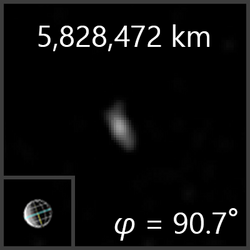Astronomy:Elara (moon)
 Elara imaged by the LORRI instrument aboard New Horizons | |
| Discovery [1][2] | |
|---|---|
| Discovered by | Charles D. Perrine |
| Discovery site | Lick Observatory |
| Discovery date | 5 January 1905 |
| Designations | |
Designation | Jupiter VII |
| Pronunciation | /ˈɛlərə/[4] |
| Named after | Ελάρα Elăra[3] |
| Adjectives | Elarian /ɛˈlɛəriən/ |
| Orbital characteristics [5] | |
| Epoch 27 April 2019 (JD 2458600.5) | |
| Observation arc | 113.70 yr (41,528 days) |
| 0.0782306 astronomical unit|AU (11,703,130 km) | |
| Eccentricity | 0.1961487 |
| Orbital period | +258.65 d |
| Mean anomaly | 10.93078° |
| Mean motion | 1° 23m 30.67s / day |
| Inclination | 30.51712° (to ecliptic) |
| Longitude of ascending node | 90.86474° |
| 191.19922° | |
| Satellite of | Jupiter |
| Group | Himalia group |
| Physical characteristics | |
| Mean diameter | 79.9±1.7 km[6] |
| Albedo | 0.046±0.007[6] |
| Apparent magnitude | 16.6[7] |
| Absolute magnitude (H) | 9.6[5] |
Elara /ˈɛlərə/ is a prograde irregular satellite of Jupiter. It was discovered by Charles Dillon Perrine at Lick Observatory in 1905 in photographs taken with the 36" Crossley reflecting telescope which he had recently rebuilt.[1][8] It is the eighth-largest moon of Jupiter and is named after Elara, one of Zeus's lovers and the mother of the giant Tityos.[9]
Elara did not receive its present name until 1975; before then, it was simply known as Jupiter VII. It was sometimes called "Hera"[10] between 1955 and 1975. It has a mean radius of just 43 kilometres (27 mi), thus it is 2% of the size of Europa. However, it is half the size of Himalia, so it is the second-biggest moon in the Himalia group. It might be a captured type C or D asteroid, for it reflects very little light.
Elara belongs to the Himalia group, moons orbiting between 11 and 13 gigametres from Jupiter at an inclination of about 27.5°.[11] Its orbital elements are as of January 2000. They are continuously changing due to solar and planetary perturbations.
Discovery
Elara was discovered by Charles Dillon Perrine of the Lick Observatory on January 6, 1905, the day after the discovery of Himalia, also by Perrine, was announced. However, poor weather conditions delayed the confirmation of the discovery till the 21st of February.[12]
Exploration
New Horizons encounter
In February and March 2007, the New Horizons spacecraft to Pluto captured Elara in several LORRI images from a distance of five million miles.[13]
See also
- Jupiter's moons in fiction
References
- ↑ 1.0 1.1 Perrine, C. D. (27 February 1905). "Satellites of Jupiter". Harvard College Observatory Bulletin 178. http://adsabs.harvard.edu//full/seri/BHarO/0178//0000001.000.html.
- ↑ Perrine, C. D. (1905). "The Seventh Satellite of Jupiter". Publications of the Astronomical Society of the Pacific 17 (101): 62–63. doi:10.1086/121624. Bibcode: 1905PASP...17...56..
- ↑ DGE en línea
- ↑ James Knowles (1851) A Critical Pronouncing Dictionary of the English Language
- ↑ 5.0 5.1 "M.P.C. 115889". Minor Planet Circular. Minor Planet Center. 27 August 2019. https://minorplanetcenter.net/iau/ECS/MPCArchive/2019/MPC_20190827.pdf.
- ↑ 6.0 6.1 Grav, T.Expression error: Unrecognized word "etal". (August 2015). "NEOWISE: Observations of the Irregular Satellites of Jupiter and Saturn". The Astrophysical Journal 809 (1): 9. doi:10.1088/0004-637X/809/1/3. 3. Bibcode: 2015ApJ...809....3G.
- ↑ Sheppard, Scott. "Scott S. Sheppard - Jupiter Moons". Department of Terrestrial Magnetism. Carnegie Institution for Science. https://sites.google.com/carnegiescience.edu/sheppard/moons/jupitermoons.
- ↑ Perrine, C. D. (1905). "The Seventh Satellite of Jupiter". Publications of the Astronomical Society of the Pacific 17 (101): 62–63. doi:10.1086/121624. Bibcode: 1905PASP...17...56..
- ↑ Marsden, Brian G. (7 October 1975). "Satellites of Jupiter". International Astronomical Union. http://www.cbat.eps.harvard.edu/iauc/02800/02846.html.
- ↑ Payne-Gaposchkin, Cecilia; Katherine Haramundanis (1970). Introduction to Astronomy. Englewood Cliffs, N.J.: Prentice-Hall. ISBN 0-13-478107-4.
- ↑ Jacobson, R. A. (2000). "The orbits of outer Jovian satellites". Astronomical Journal 120 (5): 2679–2686. doi:10.1086/316817. Bibcode: 2000AJ....120.2679J. https://trs.jpl.nasa.gov/bitstream/2014/15175/1/00-1187.pdf.
- ↑ Proctor, Mary (March 5, 1905). "Jupiter's Newly Discovered Moons and Solar Cyclones". https://www.newspapers.com/clip/110687001/elara-discovery/. Retrieved October 4, 2022.
- ↑ Hamilton, Thomas Wm. (2013). Moons of the solar system. Strategic Book Publishing. p. 21. ISBN 978-1625161758. https://books.google.com/books?id=wg4ELSuruqQC&pg=PA21.
External links
- Elara on 1998-08-15 03:21 UTC(Crédit: OHP/IMCCE/CNRS)
- SkyView 23 47 09 -02 40 46
- HORIZONS Web-Interface, JPL
- Elara: Overview by NASA's Solar System Exploration
- David Jewitt pages
- "Two Irregular Satellites of Jupiter" (Himalia & Elara: Remanzacco Observatory: November 23, 2012)
 |
